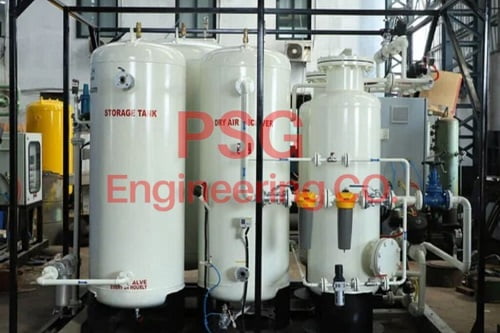- 493, Devlok Colony, Swarg Ashram Road, Hapur - 245101, Uttar Pradesh, India
- psgengineeringco@gmail.com
- +91-8126173604
What is an Oxygen Gas Plant?
An oxygen gas plant is a facility designed for the production of oxygen gas through various methods such as cryogenic distillation, pressure swing adsorption (PSA), or vacuum pressure swing adsorption (VPSA). These plants are engineered to separate oxygen from other components of air, such as nitrogen and argon, to obtain high-purity oxygen gas suitable for specific applications.

Medical Applications
One of the most critical uses of oxygen gas plants is in the healthcare sector:
- Oxygen Therapy: Oxygen produced by these plants is used in hospitals and clinics for therapeutic purposes, particularly in cases of respiratory distress or chronic obstructive pulmonary disease (COPD). It helps patients breathe more easily and increases the oxygen concentration in their blood.
- Emergency Situations: Oxygen is vital in emergency rooms, during surgeries, and in ambulances to stabilize patients and support various medical procedures.
- Home Healthcare: Portable oxygen concentrators, which operate on similar principles to oxygen plants, provide continuous oxygen supply to patients at home, enhancing their quality of life.
Industrial Applications
Oxygen gas plants are indispensable in several industrial processes due to their ability to enhance combustion and improve efficiency:
- Metallurgy: In steelmaking and metal cutting industries, oxygen is used to increase combustion temperatures in furnaces and to facilitate the production of metals like steel, aluminum, and copper.
- Chemical Synthesis: Oxygen is a crucial element in various chemical processes, including oxidation reactions, production of plastics, and synthesis of pharmaceuticals.
- Waste Treatment: Oxygen gas plants are used in wastewater treatment facilities to enhance microbial activity, aiding in the breakdown of organic matter and pollutants.
Environmental Applications
Oxygen gas plants also contribute significantly to environmental conservation efforts:
- Water Treatment: Oxygen is injected into water bodies such as lakes and reservoirs to improve water quality and support aquatic life by increasing dissolved oxygen levels.
- Bioremediation: In remediation projects, oxygen gas helps stimulate the growth of aerobic bacteria that break down contaminants in soil and groundwater.
Aerospace and Scientific Research
In the aerospace industry and scientific research, oxygen gas plants are pivotal for:
- Space Exploration: Oxygen is essential for life support systems in spacecraft and habitats on other planets, providing breathable air for astronauts.
- Research Facilities: Laboratories and research institutions use high-purity oxygen in experiments and studies that require controlled atmospheres.
Advantages of Oxygen Gas Plants
The advantages of oxygen gas plants are manifold:
- Reliability: They provide a continuous and reliable source of oxygen, crucial in critical applications like healthcare and industrial processes.
- Cost-effectiveness: Oxygen gas plants offer long-term cost savings compared to traditional cylinder or liquid oxygen supply methods.
- Customization: Plants can be tailored to meet specific purity and volume requirements, ensuring optimal performance in diverse applications.
Conclusion
In conclusion, oxygen gas plants are indispensable assets across multiple sectors, from healthcare to industry and environmental conservation. Their ability to produce high-purity oxygen efficiently and sustainably makes them vital for improving human health, advancing industrial processes, and supporting environmental sustainability efforts. As technology continues to advance, these plants will play an increasingly pivotal role in meeting the growing global demand for oxygen in a wide array of applications.
Whether in hospitals saving lives or in industrial settings optimizing processes, the impact of oxygen gas plants resonates deeply in our modern world, underscoring their status as indispensable technological marvels.
